How to Create a Training Manual That Employees Will Enjoy

What images come to mind when you hear the phrase “training manual”? Chances are you imagine a little printed book or a booklet. Of course, this format still exists, but such manuals tend to be text-heavy, and reading them is often a dull experience that takes a lot of time. It would be hard to find an employee who enjoys studying this manual.
Fortunately, there are now many other options. Technology has changed the way we make training manuals and how they look. Modern digital manuals may be visually attractive, brief but effective, and engaging for employees. Moreover, by combining different elements like videos, infographics, and audio recordings, they cater to different learning styles and increase learner retention.
Instead of coercing your staff to read a boring fire safety operational booklet, for example, you can create an interactive online manual your employees will be happy to engage with.
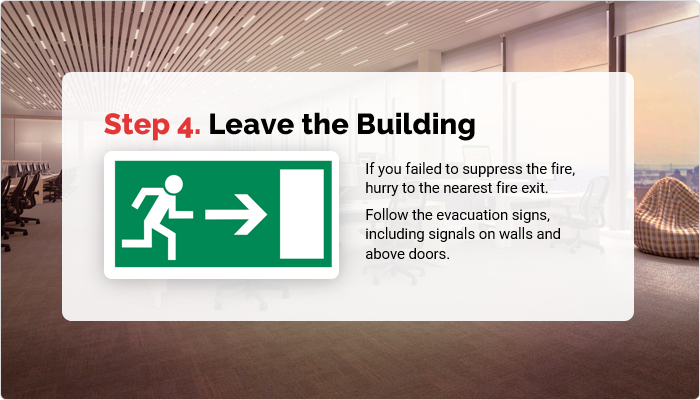
This fire safety training manual covers essential topics that
will help you know what to do in case of a fire.
In this article, we’ve put together some key points you need to consider and steps you can follow to create an engaging training manual that employees will love.
What is a Training Manual?
A training manual is a set of instructions used to improve the quality of a task, process, or job. Its ultimate goal is to provide employees all the tools and information they need to excel at their jobs.
There are two types of training manual:
Employee handbook
This is an employee training manual that new hires get on the day they enter a company. They provide the rules and regulations every employee needs to follow at work, along with general information about the company: its mission, values, and culture. The main purpose of a handbook is to set clear expectations for the staff, while also stating legal obligations and employee rights. Another important aspect of such a manual is introducing newbies to the corporate culture and how they can fit in.
For example, Disqus’ handbook is divided into two parts: the first half is an official, “legalese” document, and the second is a culture book.
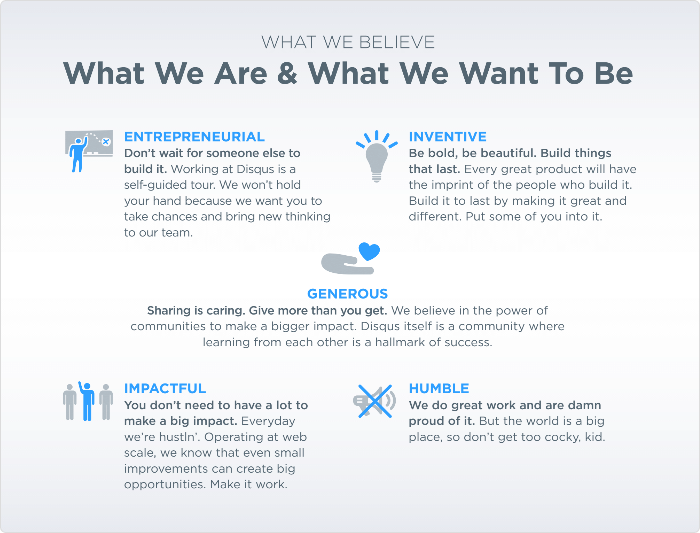
Self-paced guide
These training manuals provide specific position-related information. They enable employees to carry out their duties effectively and help them if they get stuck somewhere along the way. Thus, a training manual for a lab assistant will be completely different from one for a customer support engineer.
There may also be task-related or project-related manuals, like a guide to writing memos or a manual about using Google Analytics.
Why are Training Manuals Important?
Training manuals are valuable resources for your company that will never be obsolete. Your employees will use manuals from year to year, and these are the benefits you can expect:
- Faster onboarding of new hires. By understanding where to go and having all the necessary instructions, new employees quickly acquire knowledge, skills, and behaviors and become effective members of the company.
- Better employee efficiency. Employee training manuals help teams grow and improve in their jobs. They ensure that employees don’t miss crucial instructions. Step by step, people achieve their goals quicker.
- Higher employee retention. When employees face issues at work, feel embarrassed to ask for help and have no job aids to engage with, they get frustrated and disengaged. A good training manual provides all the information they need, so employees can find solutions and work issues out on their own, boosting their satisfaction.
- Less employee workload. Providing employees all the necessary guidance means keeping managers and HR specialists from having to answer the same questions over and over again. They can use this time for more important tasks, like developing business strategies or recruiting new talents.
- Fewer costly mistakes. Noncompliance with rules may cost you a fortune. If an invoice isn’t sent correctly, for instance, your company won’t receive needed funds. You can minimize this risk by having all your procedures documented in a training manual.
What Should Be Included in a Training Manual
Now that you understand the significance of these resources, let’s delve into the essential elements that should be included to create a comprehensive training manual.
- Introduction: Provide an overview of the training manual and its objectives.
- Training goals and objectives: Clearly define what participants should achieve after completing the training.
- Learning content: Provide detailed information on the topic you’d like to cover.
- Assessments: Decide how employees’ knowledge will be evaluated — whether it will be with quizzes, exams, or practical tasks.
- Resources and references: Provide a list of recommended resources, books, articles, or websites that participants can refer to for further studies.
- Frequently asked questions: Anticipate common questions that employees may have and provide clear answers to address them.
- Glossary: Define any technical terms or jargon used in the manual to ensure that trainees understand the terminology.
A Step-by-Step Guide to Creating
a Training Manual
Creating a training manual is not as tricky as it may seem at first sight. But as with any process, it has multiple steps. We’ve brought the steps together to make the process easier for you. Just follow this guide, and you’ll get it right.
Step 1. Understand your task
In the first step of creating a training manual, you need to conduct a training audit. Look for tasks and processes in your workplace that could be streamlined, consider whether you can improve them by documenting the procedures, define the intended audience, and identify the kind of training manual that will help in each case. For example:
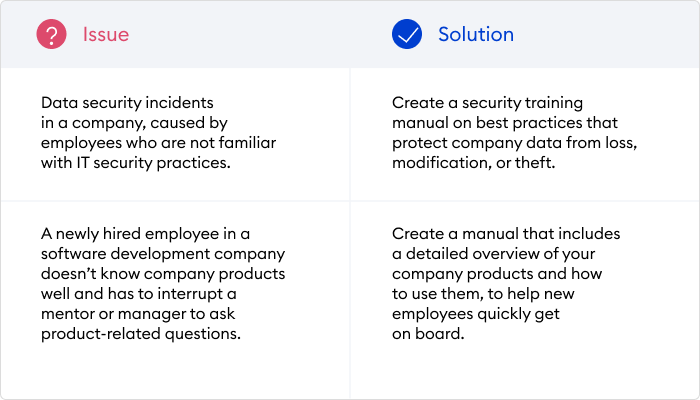
Step 2. Define the manual format
Now that you know the kind of training manuals you need to create to address your company’s needs, it’s time to determine the format in which the content will be presented. Here are a few common options:
- Printed guide books or booklets
- PDF or Word manuals
- Articles
- Online courses
- Video tutorials
- Brief interactive modules
When choosing a format, you need to consider the kind of topic you want to cover. For example, if you want to demonstrate how to use software, then you’d better opt for a screencast. If your main goal is training employees on company rules and procedures, then you may want to create a training document in a PDF format, as Disqus did, or make an online course.
Step 3. Create the content
Printed booklets are quite easy to create. In fact, you only need a text editor and a printer. But this simplicity has a price: reading such materials is boring and not very effective for knowledge retention.
On the other hand, interactive modules, courses and videos require certain investments of labor. In addition, you need specific software to create such training material. But you can be certain that this approach will pay off: after all, when you invest in creating an excellent training manual once, you can then use it to train hundreds of employees.
To avoid buying numerous expensive solutions and switching between the tools, you can select a comprehensive solution like iSpring Suite Max. It is a complete authoring toolkit that will let you create manuals and other learning materials for employee training and professional development in the format of online courses. It works as a PowerPoint add-in, so if you already know how to use PowerPoint, then working with iSpring Suite will be very easy.
iSpring Suite
Fully-stocked eLearning authoring toolkit for PowerPoint. No training required to start!
In the next section, we’ll show how to create a training manual with iSpring Suite step by step.
Step 4. Deliver a manual to your employees and track
their progress
You’ve put a manual in your hands. Perhaps you’ve created an interactive masterpiece, or maybe you didn’t have the time or money to do so and have had to use PDF instructions. Whatever your training manual content is, you need to deliver it to all employees and make sure they study it.
The best solution here is a learning management system (LMS). An LMS will let you store all of your manuals and other training materials in a single location, as well as assign the content to your employees and keep track of how they’re viewing it. This is a must-have tool for continuous learning and employee development.
If you don’t have an LMS, opt for an intuitive platform such as iSpring Learn to start an online training experience right away.
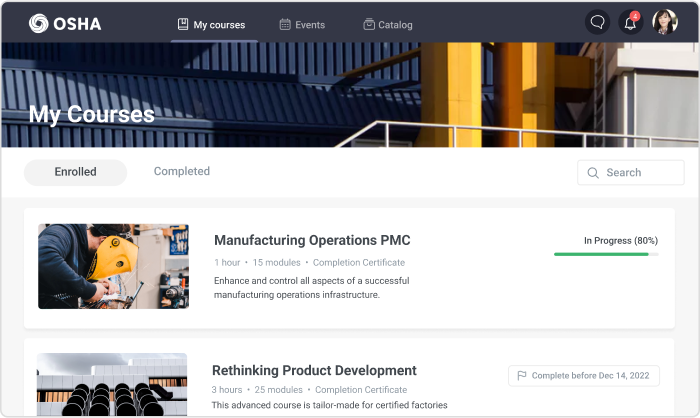
With iSpring LMS, you can:
- Create a unified knowledge base to store all the training manuals and other instructional content
- Build comprehensive training programs and categorize audiences to offer your employees personalized learning paths
- Automate training management tasks, like sending invites and reminders and managing deadlines
- Host virtual training sessions and track employee attendance
- Create detailed reports to evaluate the success of your employee training
- Deliver on-the-go training with the iSpring Learn native mobile app
- Customize the system with your corporate branding for a seamless user experience
- Engage your employees with gamification tools, like badges and leaderboards
Step 5. Collect feedback and keep your content updated
Once your employees have studied the training manual, it’s time to collect feedback. This will let you find out how useful the manual is for your employees and how it can be improved.
Ask your students questions about their learning experience. For example, you can email them a survey created in Google Forms or iSpring Suite. The best thing about using iSpring is that you can create Likert scale questions that let you see all the semitones between “poor” and “excellent” and “strongly agree” and “strongly disagree.”
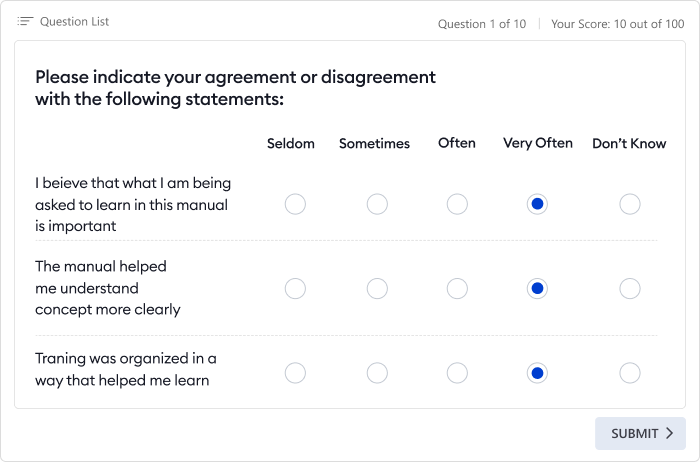
After you consider these insights on how to make your training guide even better, you may want to update it: add more valuable information, refine the design, or even convert the manual to another format. It might also need to be updated if some processes in your company have changed, or you have released new products and features, or the government decided to amend the law.
Be sure to collect all the source files for the entire manual so you can come back to them and make updates easily.
How to Create an Interactive Training Manual with PowerPoint
PowerPoint is a great tool that allows you to create a presentation that will serve as a manual. But to make your training manuals interactive, truly engaging, and effective, you’ll need iSpring Suite. As mentioned, iSpring Suite is integrated with PowerPoint, so you don’t need to learn how to navigate new software. Once you’ve installed the tool, the iSpring Suite tab will appear in the familiar PPT interface.

Now let’s see how to create a training manual with these two simple tools step by step.
1. Create a PowerPoint presentation
First, you need to build a presentation. Put the information on your training topic into the slides. But keep in mind that people can’t handle a lot of text on your slides, so add only the main concepts. If you want to provide some additional information, support the text with images, infographics, and videos. You can also record a voice-over once your presentation is ready.
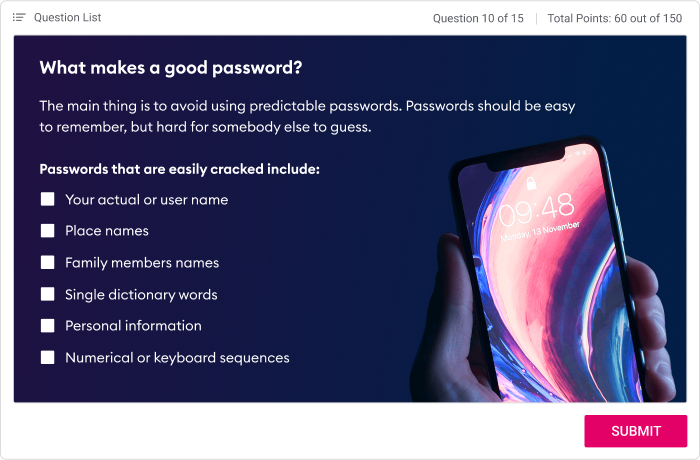
2. Add a voice-over
If you’re not going to create a narration, skip this step and go to the next one. But if you’d like to provide your employee with some more details by creating a voice-over, go to the iSpring Suite tab.
With iSpring Suite, you can:
- Record an audio narration for your training manual
- Record a video narration that will let your learners see not only slides, but also a narrator
- Convert your text to a compelling voice-over by using iSpring’s
text-to-speech tool
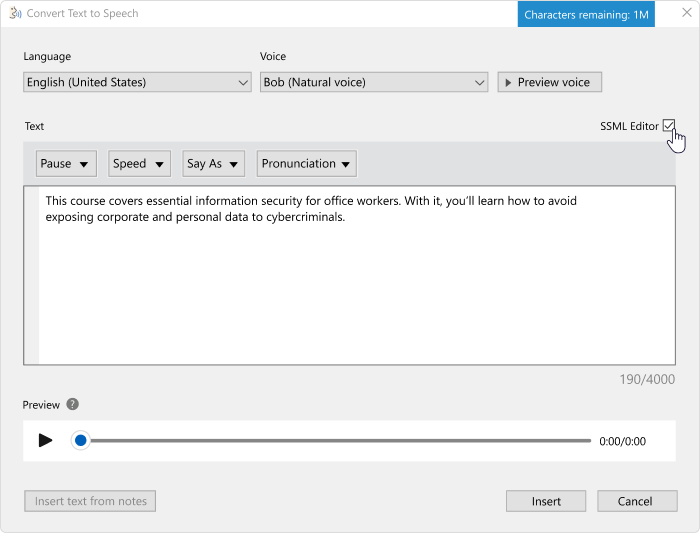
3. Record a video tutorial
Some processes, like repairing a laptop or fixing a printer, can be difficult to explain using text and pictures alone. By viewing training videos with clear narration, subtitles, and highlights of key points, however, it becomes possible even for new employees to perform their tasks.
Of course, you can record such a video with your camera, but to make it look professional and enhance it with images and captions, you’ll need separate video editing software. But with iSpring Suite, you can record and edit a webcam video with a single tool.
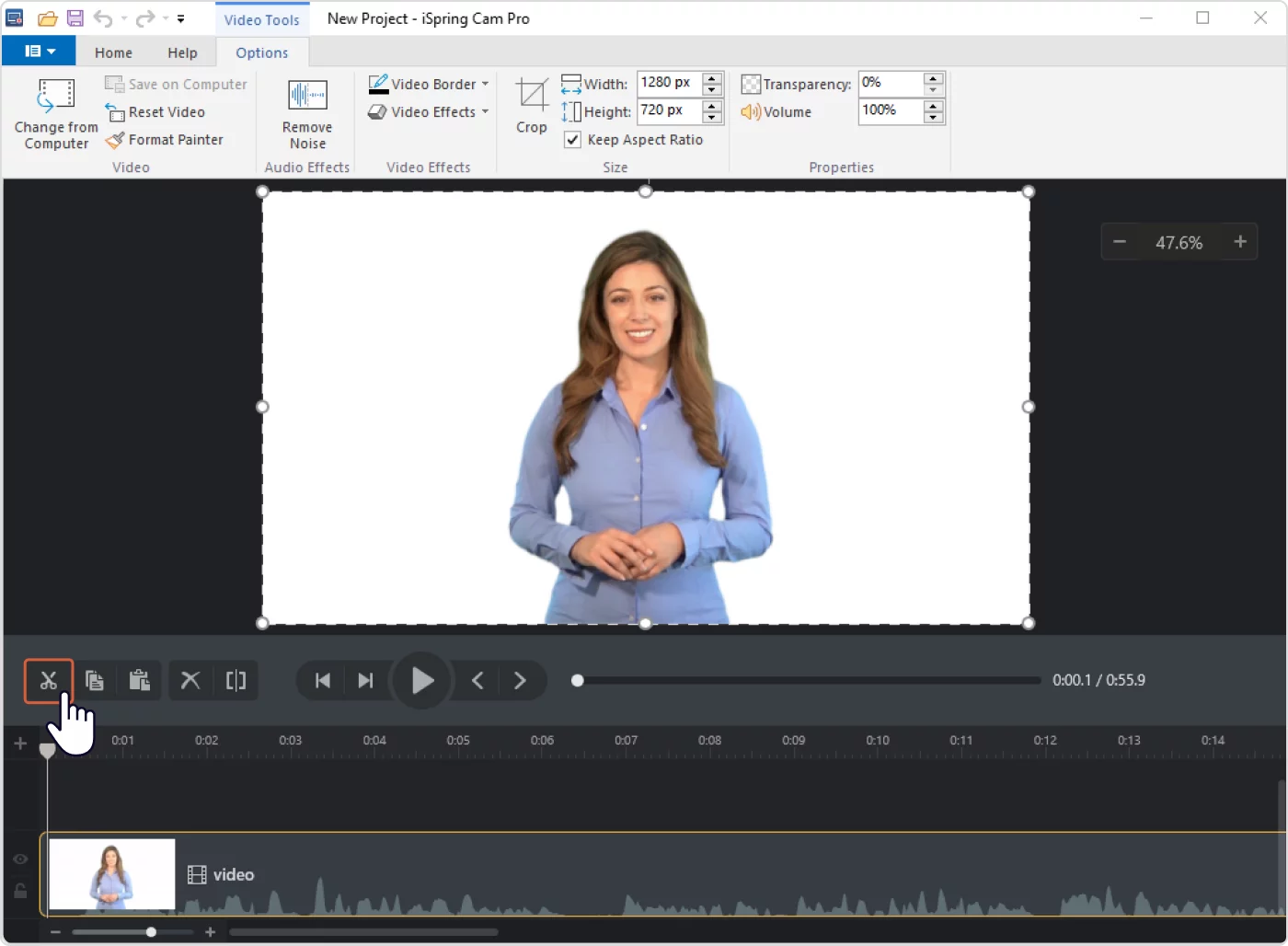
If you want to teach employees how to properly use some digital tools, such as CRM or an email service, then the best solution is to record a screencast. With iSpring, you can capture your screen, together with a webcam or audio. You can even highlight the cursor and add click sounds to draw attention to your actions on the screen. Add a visual hint for each step, so your employees can repeat your actions easily:
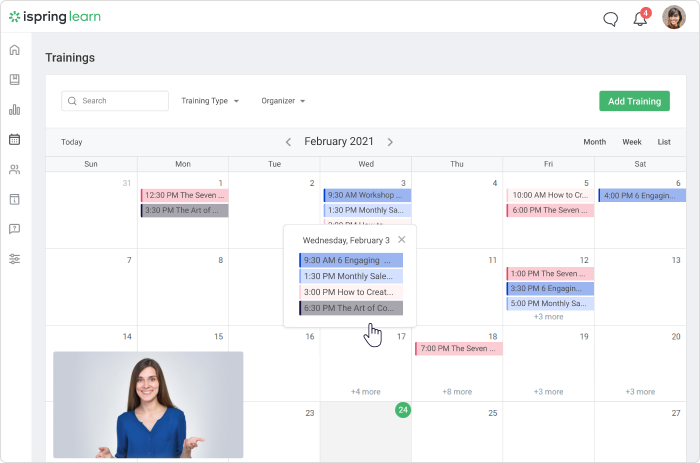
4. Create brief interactive modules
If you want to provide your employees with a quick guide on, say, how to conduct a SWOT analysis, visualize your brand values, or present an online office tour, then you can use interactions. They are another way of providing a great deal of information on a slide without overloading it with text.
iSpring Suite comes with fourteen interaction types: FAQ, Timeline, Tabs, Glossary, Steps, and more. You only need to choose a suitable template and fill it with your text and images.
This is a slide from a brief guide that introduces your office and future workplace to your new hire:
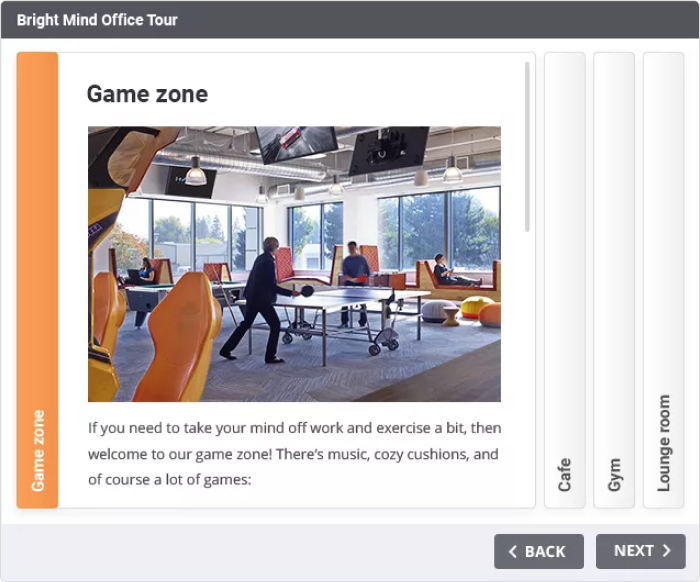
5. Build a role-play simulation
If you’d like to provide your employees with hands-on experience, especially if you’re training them in communication skills, customer service skills, or management tactics, create a role-play.
With iSpring Suite’s drag-and-drop interface, creating a simulation is extremely easy: just pick a suitable character and background, create the first scene, and provide response options that will lead to other scenes based on the learner’s choices.

6. Add interactive quizzes
To make sure your employees understand the information covered in your manual, you can enhance it with a quiz. iSpring Suite offers a complete set of question templates, so you can create interactive quizzes quickly and hassle-free. You can use the ubiquitous multiple-choice and true-false questions, as well as highly engaging drag-and-drops and hotspots — 14 question types in all.
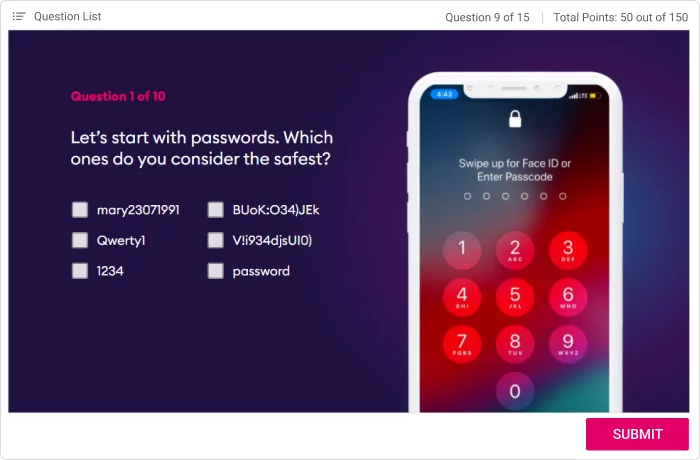
7. Publish your training manual
Now that you have your manual all set and ready to go, you need to put it into an online format. If you want to post your online training manuals on your website or email them to your trainees, you can save files in HTML5. Alternatively, if you’re planning to upload your guidelines to an LMS, choose an eLearning format: SCORM, AICC, Tin Can (xAPI), or cmi5, depending on what your LMS supports. If necessary, you can even save your content as an MP4 file for uploading directly to YouTube from iSpring Suite.
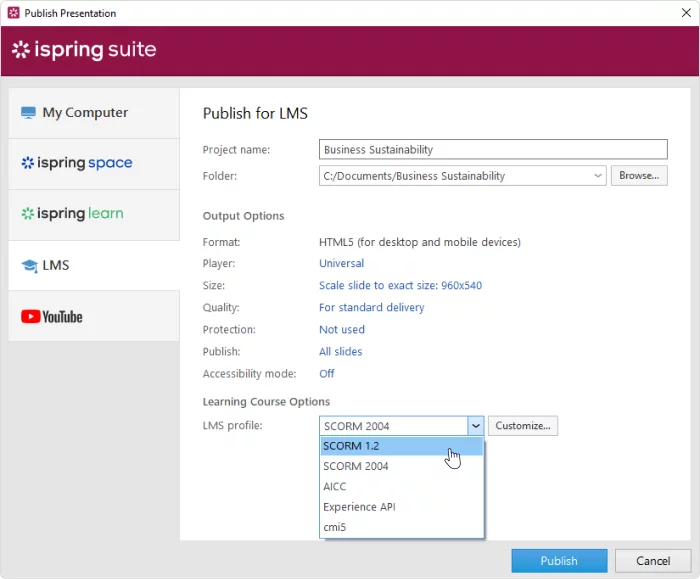
Congratulations! You’ve made your own training manual. If you’d like to see iSpring Suite in action and try to create a training manual, download its 14-day free trial.
Training Manual Template
If you’re a large enterprise with hundreds or even thousands of employees, you might need a variety of training manuals for different job roles.
Of course, creating each manual from scratch is time-consuming. The best way to reduce the development time is to make a training manual template once. You’ll take care of the basic elements, like shape, texture and color, and then have more time and space to focus on the content. This will also help ensure that all your learning materials have a consistent look and feel that aligns with your organization.
What should be included in a training manual template?
Here are the five basic elements that your training template should have:
1. Welcome screen
The welcome screen is where you can add your manual’s title and description. They must concisely introduce the topic of the particular manual and explain to a potential learner how they will benefit from studying it.

2. Objectives
Here you can outline the knowledge and skills your employees will acquire after completing the training. Properly formulated objectives ensure that learners know what to expect and feel more prepared for the workload.

3. Main menu
This slide contains the table of contents. It allows your learners to move around to different modules of your manual.
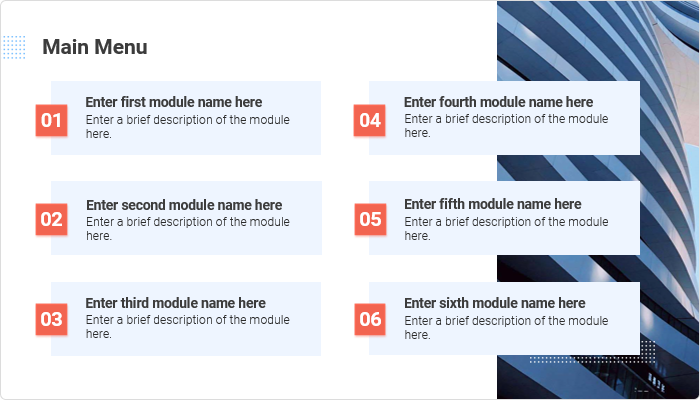
4. Content
Module content is the heart of your training. Various layouts can be repurposed for different types of content. Here are a few examples:
| Image slides | Company products | Video |
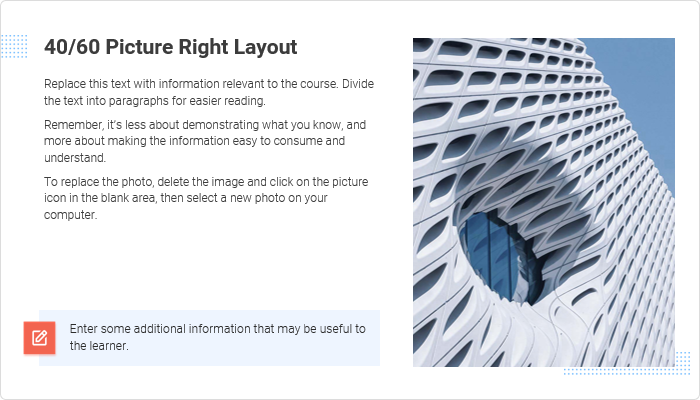 |  |  |
| Statistics | Process | Problem and solution |
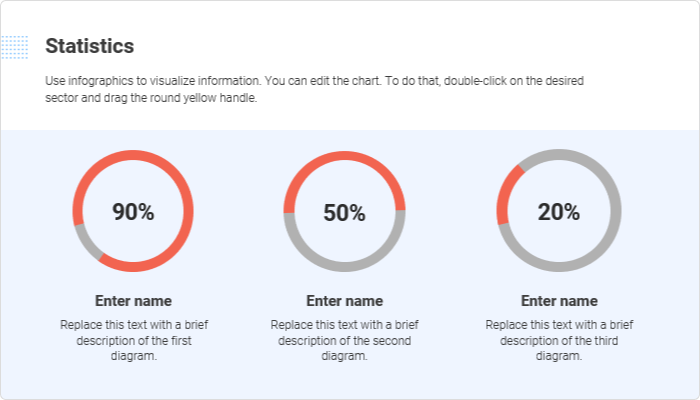 | 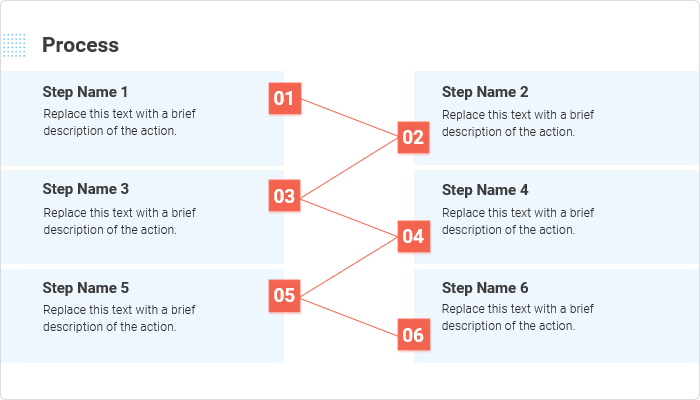 | 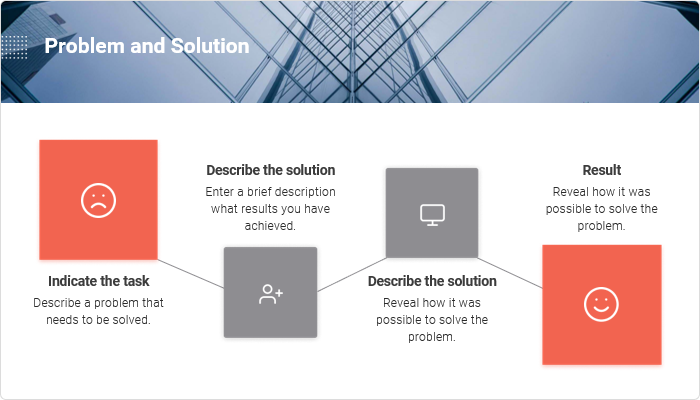 |
5. Conclusion
This slide summarizes the results a learner has achieved. Here you can outline the skills and knowledge they have acquired, congratulate employees on their successful completion of training, or direct them to the next step of their training program.

To help you streamline your content creation process, we’ve prepared a training manual template that you can download for free. It’s a PowerPoint template, so you can easily customize it to your needs; for example, to tweak it a little to best represent your brand.
Download the free training manual template →
You can get over 450 slide templates with iSpring Suite. Besides templates, it provides a great variety of backgrounds (offices, universities, living spaces, and more), characters of different ages, appearances, and professions — both photographic and illustrated — and a complete set of icons for all possible needs.
Training manual FAQs
We’ve put together a list of FAQs about a training manual, and we’ll update this blog with any new questions you ask in the comment section.
Are handbooks and manuals the same?
Handbooks and manuals are basically the same. However, there’s a slight difference: handbooks are more focused on rules, regulations, and policies, while manuals provide guidelines and instructions.
What is the purpose of a training manual?
The purpose of a training manual is to provide comprehensive instructions and guidelines to help individuals acquire the necessary knowledge for a specific task, job, or process. It serves as a reference tool to ensure consistency in training and enables employees to perform their responsibilities effectively.
How do training manuals benefit organizations and employees?
Training and reference manuals benefit both the employee and employer by providing a standardized resource that ensures consistent training across the organization. They serve as a reference guide for employees to understand the policies, procedures, and the necessary practices to perform their jobs effectively.
One major benefit of training manuals is that they promote efficiency and productivity. By providing employees with a clear outline of their expected tasks and how to perform them, manuals streamline the training process. This results in faster onboarding for new hires, as they can refer to the manual to guide them through their training. Moreover, existing employees can refer back to the manual whenever they need clarification or a refresher on specific processes or procedures. This saves time and minimizes errors caused by inconsistencies in training.
How to write a training manual?
Training manual templates are a perfect way to streamline your content creation. Here are a few tips on how to make a well-written training manual template:
- Start with an outline. Create a clear and logical structure for your training guide. Break it down into sections and subsections with headings and subheadings. This will make it easier for readers to navigate and find relevant information.
- Use clear, concise language. Write in a straightforward language that’s easy for readers to understand. Avoid technical jargon or complex terminology that might confuse your employees.
- Use a step-by-step approach. Present information in a sequential manner, ensuring that each step is clear and easy to follow. Numbered or bulleted lists can be an effective way to break down instructions.
- Provide examples and practical exercises. Supplement your explanations with real-life examples and practical exercises. This will help your employees apply what they have learned and reinforce their understanding.
- Format consistently. Maintain a consistent formatting style throughout the manual for headings, fonts, colors, and spacing. This will make it visually appealing and easier to read.
How to make a training manual interactive?
With authoring tools like iSpring Suite Max, you can turn boring instructions into engaging interactive content. Here are just a few ways to add interactivity to your manual:
- Use branching scenarios to let employees choose their own path within a manual, providing an individual learning experience for each learner.
- Incorporate quizzes. Enrich your manual with interactive quizzes, like drag-and-drop and hotspot activities.
- Add interactions. Include the abovementioned brief interactive modules in your training manual.
What are the best practices for using training manuals effectively?
- Provide clear instructions: Ensure that instructions are written in a clear and concise manner, so employees understand what is expected of them. Use action verbs and provide examples to clarify expectations.
- Include real-world examples: Use relevant examples and scenarios to make the content relatable to employees. This helps them understand how to apply the knowledge and skills learned in their daily work.
- Update and revise regularly: Training manuals should be regularly updated and revised to reflect any changes in policies, practices, or technology.
- Encourage feedback: Request feedback from employees on the relative usefulness and effectiveness of the training manual. This feedback can help identify areas for improvement and make future manuals more effective.
- Provide additional resources: Supplement the training manuals with additional resources such as handouts, reference guides, or videos. This allows participants to further explore the topic and reinforce their learning.
How often should a training manual be updated?
The frequency of updating a training manual depends on various factors, such as changes in processes, procedures, technology, regulations, best practices, or company policies. However, as a general guideline, it is suggested that training manuals be reviewed and updated at least once a year. Additionally, it is crucial to update the manual whenever there are significant changes that might impact the accuracy or effectiveness of the training content. This ensures that the information remains up to date and relevant for the trainees.
Final Thoughts
Companies that invest in corporate training have 218% higher income per employee than organizations without formalized training. This is not surprising, as they get a return on such investment through better employee productivity and efficiency.
If you are going to create training manuals that are more than just boring text with ease, you need the right tools. Get the iSpring Suite free trial and start making engaging learning materials right away! Also, download our free template and create a winning training manual today.







